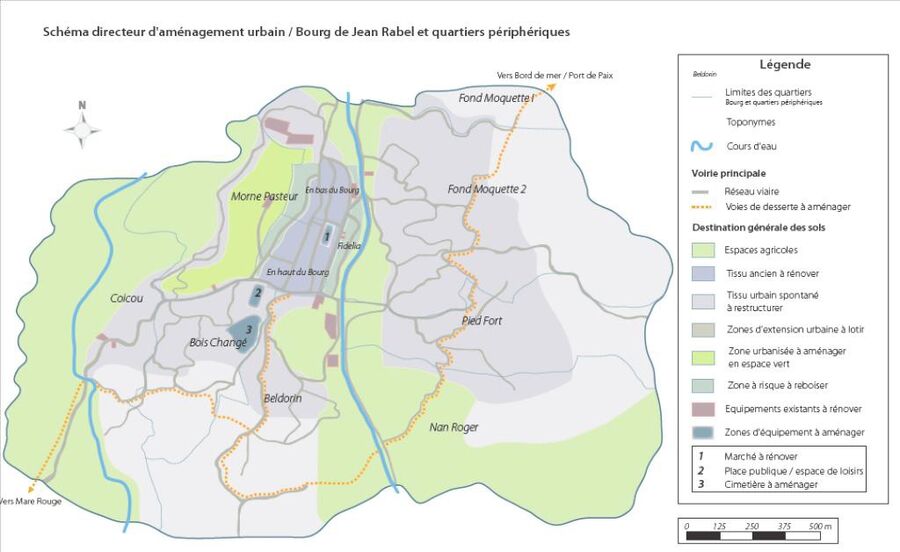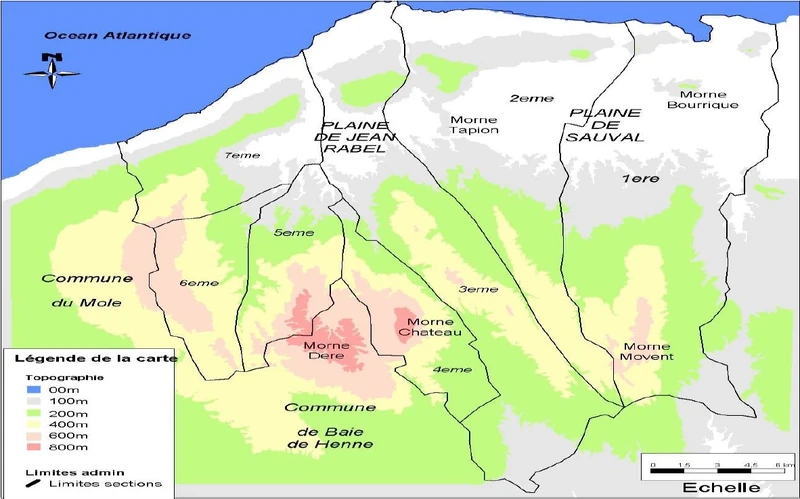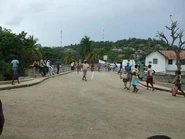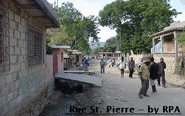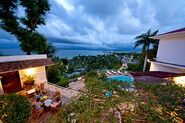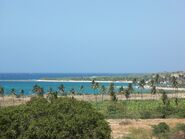No edit summary |
No edit summary |
||
| Line 21: | Line 21: | ||
Here, arid valleys and deforested hills alternate with greener areas. Saying that the region is isolated is an understatement. Haiti’s Northwest ''"feels like a place untouched by the passage of time"''. In Jean-Rabel and in the rural areas surrounding the city, life probably isn’t that different now from what it was a century ago. |
Here, arid valleys and deforested hills alternate with greener areas. Saying that the region is isolated is an understatement. Haiti’s Northwest ''"feels like a place untouched by the passage of time"''. In Jean-Rabel and in the rural areas surrounding the city, life probably isn’t that different now from what it was a century ago. |
||
| + | |||
| ⚫ | |||
| + | |||
| ⚫ | The locale offers the delight of virgin territory to the visitor, having been largely unvisited by foreigners as no direct flight can take you to the remote, but aesthetically pleasing place. Even the number of inhabitants don't offer much by way of number, but some think this an advantage. Aside from the area remaining relatively unindustrialized, and so still full of Haitian flora and fauna, the relative remoteness has made the inhabitants extremely self-sufficient. |
||
==History== |
==History== |
||
| Line 51: | Line 55: | ||
• In '''1892''', the state gave G500 to repair the Church. |
• In '''1892''', the state gave G500 to repair the Church. |
||
| − | |||
| ⚫ | |||
| − | |||
| ⚫ | The locale offers the delight of virgin territory to the visitor, having been largely unvisited by foreigners as no direct flight can take you to the remote, but aesthetically pleasing place. Even the number of inhabitants don't offer much by way of number, but some think this an advantage. Aside from the area remaining relatively unindustrialized, and so still full of Haitian flora and fauna, the relative remoteness has made the inhabitants extremely self-sufficient. |
||
==Geography== |
==Geography== |
||
| Line 63: | Line 63: | ||
It is bordered on the north by the [https://en.wikipedia.org/wiki/Atlantic_Ocean| Atlantic Ocean], on the east by the municipality of [[Port-de-Paix]], on the southeast by the [[Artibonite|Artibonite Department]] town of [[Anse-Rouge]], on the southwest by the municipality of [[Baie-de-Henne]], and on the west by the municipality of [[Môle Saint-Nicolas]]. |
It is bordered on the north by the [https://en.wikipedia.org/wiki/Atlantic_Ocean| Atlantic Ocean], on the east by the municipality of [[Port-de-Paix]], on the southeast by the [[Artibonite|Artibonite Department]] town of [[Anse-Rouge]], on the southwest by the municipality of [[Baie-de-Henne]], and on the west by the municipality of [[Môle Saint-Nicolas]]. |
||
| − | The city is located about 32 km (''20 |
+ | The city is located about 32 km (''20 mi.'') from [[Môle Saint-Nicolas]] 40km (''25 mi.'') from [[Port-de-Paix]] and 250 km (''155 mi.'') from the capital [[Port-au-Prince]], in the Saint-Nicolas Mountain Range, which culminates at the '''Pic Morvan''' (Morvan Peak) at 800 meters (''2,400 feet'') of altitude and the '''Mont Château''' (Mount Castle) at 840 meters (''2,520 feet''); as well as on the mountain massif of Jean-Rebel which reaches 850 meters (''2,550 feet'') of altitude. |
| − | The commune of Jean-Rabel spans 7 communal sections, 5 of which are made up of mountainous areas at |
+ | The commune of Jean-Rabel spans 7 communal sections, 5 of which are made up of mountainous areas at temperate and cool temperatures. The other two communal sections are dominated by a valley and a plain at normal temperature. The town center (''Ville de Jean-Rabel''), is located in the middle of a fertile valley, on the left bank of the river, which sometimes overflows and which flows into the Cove of Jean-Rabel. Due to its existence at its church, which was built before 1743, it is located a high league from its pier, located itself at the mouth. |
Jean-Rabel's seven [[Administrative division|communal sections]]: [[Lacoma]], [[Guinaudée]], [[Vielle Hatte]], La Montagne, [[Dessources]], Grande Source, and [[Diondion]]. La Ville de Jean-Rabel, the town's commercial and administrative center, houses the decentralized services of the State, the municipal administration, the hospital, some large school institutions (the colleges, religious congregation schools) and the most important religious buildings in the commune. It is also in the town center that we find the largest population concentration of the municipality (more than 13,000 inhabitants, this figure takes into account the new quarters). The communal sections play little role in the administrative plan. They are classified in order according to the size of their population. The seven communal sections are further divided into habitations that themselves are subdivided into localities. The number of homes and localities varies from one section to another. It has several zip codes and over 595 localities. |
Jean-Rabel's seven [[Administrative division|communal sections]]: [[Lacoma]], [[Guinaudée]], [[Vielle Hatte]], La Montagne, [[Dessources]], Grande Source, and [[Diondion]]. La Ville de Jean-Rabel, the town's commercial and administrative center, houses the decentralized services of the State, the municipal administration, the hospital, some large school institutions (the colleges, religious congregation schools) and the most important religious buildings in the commune. It is also in the town center that we find the largest population concentration of the municipality (more than 13,000 inhabitants, this figure takes into account the new quarters). The communal sections play little role in the administrative plan. They are classified in order according to the size of their population. The seven communal sections are further divided into habitations that themselves are subdivided into localities. The number of homes and localities varies from one section to another. It has several zip codes and over 595 localities. |
||
Revision as of 18:24, 3 July 2020
Jean-Rabel (Kreyòl: Jan Rabèl) is a commune located on the shore of the Windward Passage in Northwestern Haiti. With a population of 150,000 residents, Jean-Rabel is the largest city in the Môle Saint-Nicolas Arrondissement and the 15th most populous city in Haiti. The metropolitan area has a population of just over 250,000 people.
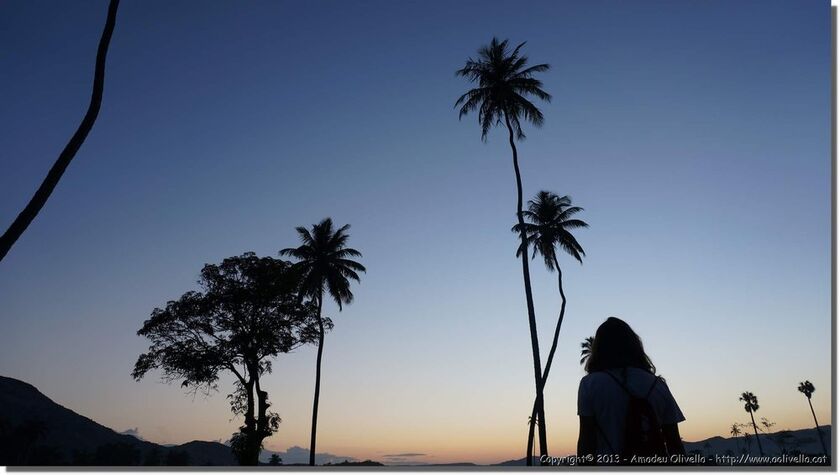

Location in Haiti

Welcome sign

Location in the Western Hemisphere

Business leader addressing the remote and underserved city's needs, "the place that Port-au-Prince forgot about"
About
Founded in 1734, Jean-Rabel was first a parish before being raised to the rank of commune on October 17, 1821.
Jean-Rabel is an isolated town almost at the top of Haiti’s northern peninsula. The city is located less than 300 km (185 miles) from the capital, yet getting there is a 7-hour journey, half of it on bumpy mountain dirt roads. It is located in a mountainous region which is very arid in comparison with the rest of the country. There are around 140,000 people in the municipality. The people live in different places scattered across the hills and they mainly live off raising livestock and farming.
Here, arid valleys and deforested hills alternate with greener areas. Saying that the region is isolated is an understatement. Haiti’s Northwest "feels like a place untouched by the passage of time". In Jean-Rabel and in the rural areas surrounding the city, life probably isn’t that different now from what it was a century ago.
Environment
The locale offers the delight of virgin territory to the visitor, having been largely unvisited by foreigners as no direct flight can take you to the remote, but aesthetically pleasing place. Even the number of inhabitants don't offer much by way of number, but some think this an advantage. Aside from the area remaining relatively unindustrialized, and so still full of Haitian flora and fauna, the relative remoteness has made the inhabitants extremely self-sufficient.
History
Christopher Columbus landed in a section of Haiti, populated by the Taínos, called Marién. Today, that mountainous district 250 km (150 miles) to the north of Haiti's capital is called Jean Rabel. Part of Haiti's North West Department, the city of Jean Rabel can be found in the Mole Saint Nicolas County and contains many subdivisions.
• At the end of 1793, Jean Delaire, a man of color, delivered the village of Jean-Rabel to the Spaniards; but the English came there with superior forces, and the Spaniards gave them their place.
• On July 24, 1799, while Toussaint Louverture's army was occupied in fighting Riguad at Grand-Goâve, at the beginning of the civil war, Etienne Colard, a native of Jean-Rabel, lieutenant colonel of the 9th Colonial garrisoned at Port-de-Paix, seconded by L. Bellegarde, raised the farmers of Jean-Rabel in favor of Riguad, and came besieging the [[[Môle Saint-Nicolas|Môle]]. Maurepas resisted the incessant efforts of the insurgents. Moïse drove them out of Port-de-Paix and lifted the siege. Golart retreated to Jean-Rabel. Moses pursued him and took away Jean-Rabel. Colard retreated to rocky and inaccessible mountains from which he did not leave until 1802, when Leclerc's expedition arrived, after having supported, however, for three years, all the efforts of Toussaint Louverture's troops.
• In February 1802, at the arrival of the Leclerc expedition, the inhabitants of Jean-Rabel sent a petition to Port-de-Paix, offering the French to submit to them. General Humbert received the petition, and embarked on the frigate la Furieuse ("The Furious") with 100 men of marine artillery for Jean-Rabel.
Two leagues from Jean-Rabel stood on the shore of the sea a fort of turf occupied by the lieutenant Alain. As soon as la Furieuse presented herself for the fortification, the inhabitants of the village, knowing the feelings of Alain who had never delivered the redoubt, sent him to replace Captain Louis Etienne Golart, the implacable enemy of Toussaint Louverture and Maurepas. Golart went to Fort du Rivage, which he found occupied by the hundred men of the marine artillery. These were taken to Jean-Rabel.
Lubin Golart, Stephen's brother, marched violently against Maurepas, at Port-de-Paix, declaring that he wished to have the glory of arresting him himself, and the satisfaction of flaying him alive. Maurepas, aware of his plan by Alain, who had taken refuge with him, and seeing himself surrounded on all sides, made his submission to General Debelle at Port-de-Paix.
Lubin Golart, who had arrived on the Lacorne-Gedou, learned the submission of his enemy. He went into a violent anger, saying that he had lost the fruit of the speed of his race.
• In May 1807, Jean-Rabel responded to the insurrectional movement in Port-de-Paix by Colonel Jean-Louis Rebecca, who was against Christophe in favor of the Republic of Pétion.
• Pursued by the fleet of Christophe, Derenoncourt blew up Pétion's warship, the Constitution on February 2, 1808, in the Bay of Jean-Rabel.
• On the 8th of July the same year, Christophe's fleet cannoned Jean-Rabel, which had repulsed it.
• In May, 1865, Jean-Rabel, who had embraced the insurrection of Salnave, submitted to the government of President Geffrard. General Guillet took a position.
• On October 2, 1888, the Mancel, General Legitime's Government Service vessel, pursued a canoe in front of Jean-Rabel and took it. At this sight, the fort of Jean-Rabel fired on the Mancel a shot to which Toussaint Louverture responded.
• The law of November 20, 1821, set the precise distance from this commune to the capital at 59 leagues.
• In 1892, the state gave G500 to repair the Church.
Geography

Jean-Rabel aerial

Rivière de Jean-Rabel Jean-Rabel is located at 19.8536° N, 73.1925° W. According to the IHSI, the commune has a total area of 488.13 square kilometers (188.47 square miles), making it Haiti's ninth largest commune by land area.
It is bordered on the north by the Atlantic Ocean, on the east by the municipality of Port-de-Paix, on the southeast by the Artibonite Department town of Anse-Rouge, on the southwest by the municipality of Baie-de-Henne, and on the west by the municipality of Môle Saint-Nicolas.
The city is located about 32 km (20 mi.) from Môle Saint-Nicolas 40km (25 mi.) from Port-de-Paix and 250 km (155 mi.) from the capital Port-au-Prince, in the Saint-Nicolas Mountain Range, which culminates at the Pic Morvan (Morvan Peak) at 800 meters (2,400 feet) of altitude and the Mont Château (Mount Castle) at 840 meters (2,520 feet); as well as on the mountain massif of Jean-Rebel which reaches 850 meters (2,550 feet) of altitude.
The commune of Jean-Rabel spans 7 communal sections, 5 of which are made up of mountainous areas at temperate and cool temperatures. The other two communal sections are dominated by a valley and a plain at normal temperature. The town center (Ville de Jean-Rabel), is located in the middle of a fertile valley, on the left bank of the river, which sometimes overflows and which flows into the Cove of Jean-Rabel. Due to its existence at its church, which was built before 1743, it is located a high league from its pier, located itself at the mouth.
Jean-Rabel's seven communal sections: Lacoma, Guinaudée, Vielle Hatte, La Montagne, Dessources, Grande Source, and Diondion. La Ville de Jean-Rabel, the town's commercial and administrative center, houses the decentralized services of the State, the municipal administration, the hospital, some large school institutions (the colleges, religious congregation schools) and the most important religious buildings in the commune. It is also in the town center that we find the largest population concentration of the municipality (more than 13,000 inhabitants, this figure takes into account the new quarters). The communal sections play little role in the administrative plan. They are classified in order according to the size of their population. The seven communal sections are further divided into habitations that themselves are subdivided into localities. The number of homes and localities varies from one section to another. It has several zip codes and over 595 localities.
Communal sections
| JNR | Jean-Rabel | 148,116 | ||
|---|---|---|---|---|
| VJB | Ville de Jean-Rabel | 11,298 | ||
| QBD | Quartier Bord De Mer | 1,966 | ||
| LMA | 1ère Section Lacoma | 25,265 | ||
| GUI | 2ème Section Guinaudée | 23,423 | ||
| VIH | 3ème Section Vielle Hatte | 23,701 | ||
| LMT | 4ème Section La Montagne | 12,240 | ||
| DSC | 5eme Section Desources | 13,272 | ||
| GSO | 6eme Section Grand Source | 24,268 | ||
| DDI | 7eme Section Diondion | 12,983 |
Demographics

The inhabitants of this town are called Jean-Rabélien.
| Year | Population | Change +/- |
|---|---|---|
| 1780 | 12,000 | |
| 1890 | 10,000 | -17% |
| 1919 | 14,802 | +48% |
| 1950 | 33,372 | +125% |
| 1971 | 46,378 | +39% |
| 1982 | 67,925 | +46% |
| 1998 | 112,429 | +66% |
| 2005 | 113,267 | +1% |
| 2015 | 148,416 | +30% |
Analysis shows that the population of the commune of Jean-Rabel is relatively young (average age: 25 years). Women are slightly in the majority in rural areas, while in urban areas the rate is up by 3%. As in many other communes of the country, the population of the commune is 92% rural.
Spatial distribution of the population
The commune of Jean-Rabel is the second densest commune of the Northwest department after Port-de-Paix. The distribution of the population in space is characterized by a scattered habitat. However, a certain concentration of this population is found especially along roads, near markets and around water points. The area called Cadastre located in the northern part is the least inhabited because drought and lack of water.
Topography
The physical environment
The relief of the commune of Jean Rabel is diversified and consists of plateaus, hills, and low mountain ranges. Their height varies from 300m to 900m (1000ft to 3000ft) of altitude. The Northern part of the town, along the coast, is marked by a small massif that culminates at about 324 meters commonly called Morne Bourrique. The highest massifs are in the southern part. The most important hilly ones are: Morne Dublain (500m/1,640ft) and the Morne Movent (711m/2,333ft) in Guinaudée, the Morne Château (885m/2900ft) which is located on the edge of the 3rd and 4th section, and the Morne Déré (907m/2,975ft) which separates the commune of Jean-Rabel fron that of Baie-de-Henne. These clumps are cut from deep north-south-facing valleys.
Climate and rainfall
By the characteristics of its relief, the commune of Jean Rabel knows two well-separated climate regimes:
1. A high-altitude climate with an annual average rainfall of 1200mm (47 in.).
2. A semi-arid climate ranging from 500mm to 900mm (20 in. to 35 in.) of rain in its largest part.
The first zone is characterized by two well-marked seasons: a dry season from February to April and a rainy season interspersed sometimes a dry month during the remainder of the year. Vegetation, of a tree type, is denser in this area. This is no forest to speak of. However, there are many fruit trees, the shade of which coffee and cocoa are grown. This area covers the following communal sections: La Montagne, Vielle-Hatte (La Reserve and Bassin-Bleu), The heights of Grand-Source, Dessources and Diondion.
The semi-arid zone is very extensive. It starts east from the Bas du Moustiques, near the commune of Port-de-Paix, covers the entire northern part of the communal sections of Lacoma, Guinaudée and Ville-Hatte and extends to the west into the karstic foothills of Dessources, Grande-Source and Diondion. Observations of the cultural practices of the population and the rainfall data collected show that the semi-arid zone is characterized by four seasons: two dry seasons and two rainy seasons. The 1st rainy season goes from September to November. It is followed immediately by a dry season from December to April. The second season from the first decade of the month of May to the last decade of the month of June. The dry period resettles again in July. During the dry seasons the Wind Which results in a decrease in the flow of sources and streams.
Dry periods are detrimental to the development of agriculture. In the vast plain of 15,000 hectares (58 sq.mi.), which goes from Sauval to Lacoma, farmers are forced to practice a rain-fed agriculture that is linked to the fall of the rain. In the irrigated perimeters, the distribution of water is done under conditions that often result in conflicts between growers. Note that these seasons are not always regular. They vary from one year to the next. Over two consecutive years one month may be dry or rainy. This is the case, for example, of the month of January which was particularly rainy in 2010 and dry in 2012. The rainfall data recorded at the Désabée station in La Montagne show a disproportionate gap between the same months for the years 2003, 2004 and 2005. The analysis of this graph shows strong irregularity in the average annual rainfall. Over a 23-year period, the years follow and do not look alike.
A periodicity is established between rainy years and dry years. The year 1981 been the wettest with 1651mm of rain. Similarly, the year 2002 was the driest with 463mm of rain. These climatic instabilities are partly linked to the proximity to the commune in relation to the Tropic of Cancer, its opening on the Atlantic Ocean and the characteristics of its relief, which is subjected to a constant to the trade winds that blow for most of the year. Moreover, from November 21 to 26, 2006 between 300mm and 400mm (12in. to 16in.) of rain were spilled over the commune. These torrential rains, related to the cyclonic season, were due to the passage of a stationary tropical wave on Haiti, particularly on the regions of the Northwest, the Grande Anse and the Nippes. They caused the river overflows of the two main watersheds of the commune, (BV of Jean Rabel and BV with the result of the flooding of the town center and the plains. It should be noted that a similar flood hit the commune in April, 1971. However it is found that the municipality has a relatively fresh temperature from November to March.
Hydrography and Hydrology
The municipality of Jean-Rabel has two main watersheds; that of the River of Jean Rabel (145 km2), west of the Morne Tapion, and that of the Rivière Catinette (150 km2) east of Morne. The Rivière de Jean-Rabel measures about 23 km. It takes its source on the Morne Chateau located 885m 2,900ft above sea level. In the upper part, the river of Jean-Rabel is mainly fuelled by torrential ravines. On the first 10 kilometers of the river, there are 20 main ravines, for a single regular tributary, the Doucet River. The river of Jean-Rabel is therefore prone to sudden and devastating floods, as in November 2006, where floods erased 6 and caused extensive material damage. The banks of the river are also severely eroded.
North of the village of Jean-Rabel, 17 km after its source, the River of Jean-Rabel meets its two main tributaries: the Rivière Coicou (4.5 km) and the Rivière Prien (Praying River - 15.5km). These two tributaries also experience serious problems of erosion of their banks, in particular the Rivière Pruinier (Plum River), whose bed measures 30 to 100 meters (100 to 300ft) wide on the last 12 kilometers of its course, for an average flow of a few hundred liters per second. Very large bank arrangements would be required to control erosion and reduce the risk of destructive flooding. The last kilometers before the mouth of the river of Jean Rabel are moderately arranged, with the presence of numerous irrigated plots.
Soil
Pedologically, several types of soil are identified in the commune of Jean-Rabel. The first is an alluvial soil. It is composed of a mixture of clay and alluvium, washed away by runoff, resting on a calcium substrate. All the plains of the commune are of this composition. Of spongy nature, the land has a great capacity of water absorption. According to the analyzes made, it turned out that there is a high salt content in the soil of the alluvial plains of Jean-Rabel. It is necessary finally to highlight that this soil is pasty in the rainy season and dusty in times of drought.
The second is a karst marl. The mountains of modest altitude are mainly formed from it. It is visible everywhere in the communal sections of Diondion, Grande Source and Dessources. The soil color is brownish yellow. The observation showed that the soil of the communal section of Dessources is the most Karst. So, a few centimeters below the plantations are the rocky shoals that, once broken, give the rocks whose exploitation has experienced a certain extent during the last years in the commune.
In the upper part of the hills, the soil consists of hard limestone. This type of soil perhaps observed at Vielle-Hatte and La Montagne especially. It is colored grayish-white. On the other hand, the calcareous structure of the mountains facilitates the creation of many ravines listed here and there in the watersheds of the municipality of Jean-Rabel. Beside these types of soil that form most of the terrain of the commune, another type of lesser soil is identified in the area of the coastline of the municipality. It is coral limestone; the commune's entire coastal area is of this nature (from Port-a-l'Ecu to Diondion). Being a place on the coast, the presence of salt must be emphasized. This is the case in Charrier, a community of the Port-à-l'Ecu habitation, where salt is not exploited, is found in the hollow of the rocks.
Environment
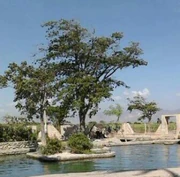
Ville Jean Rabel ak bel jaden (City of JR has beautiful gardens)
Like the other communes of the Lower North-West, two ecosystems can be distinguished in the town of Jean-Rabel:
A semi-arid ecosystem that entirely occupies Lacoma, North of Guinaudée, the northern and southern parts of Vielle-Hatte and the north of Diondion;
A tree type ecosystem in the alluvial plains and heights.
The first zone consists of savannas. There, predominate several types of trees consisting of propsopis, cacti and other species such as: bayahonde, torches, sisal, nimes, and latanier. Below these trees, corn growing, small millet, beans, pistachios (peanuts) and goat farming are practiced by farmers.
As for the second zone, several types of trees can be listed:
1) Fruit trees: mango, avocado, orange, quênier, almond, kaïmitier (endangered), corossolier, chadéquier (grapefruit), apple (cinnamon apple), etc.
2) Forest trees: oak wood, mahogany, white wood (endangered), fig tree, mapou, etc.
3) Decorative trees: flamboyant, ficus, palm kernel etc.
It should be noted that there are many coconut trees, pine trees and natural trees in the plain of Jean-Rabel and the irrigated perimeter of the plain of Sauval. Similarly, the cultivation of coffee, cocoa and tubers is practiced in the heights under the fruit trees.
In terms of fauna, several types of animals are listed in the commune of Jean-Rabel. Among which:
1) Birds and poultry: boustabac, taco, wood, nightingale, pipirite, serpentiers or picvert, crows, wild guinea fowl, petit louis, hummingbird, black-and-white ouanga, grass flower, weaver, etc.
2) Reptiles: anole, mabouya (commonly called soud loray), snake, etc.
3) Rodents: mongoose, rat, mouse ...
4) Fish and shellfish: pink fish, trevally, lobster, queen conch, etc.
It should be noted, however, that deforestation and traditional fishing have very serious consequences on the fauna in the commune. Some bird species are becoming increasingly rare. Similarly, agriculture in the savannahs is at the expense of mongooses, cats and wild guinea fowl.
The main concern for the environment of the municipality is of course that of the deforestation, but there is also a problem with the development of the town's waste management, which is increasing day by day. Moreover, the lack of protection sources and streams makes water often unsafe and a cause of disease to man and cattle. Finally, this situation of pollution of the rivers was already denounced in the first PCD by the populations of the coastal zones. One must also report the illegal dumping of toxic waste by foreign vessels into the sea. It is clear that pollution is one of the causes of diminishing fisheries resources. Due to the lack of industrial activity, habitat dispersal in communal sections, and low road traffic, the air may be considered healthy in the large part of the municipality.
Despite the efforts that have been made in this area, such as the establishment of a controlled landfill in Nan Vincent, the town hall can not totally resolve the problems of public health at the municipal level. A clear improvement is observed in terms of the amount of waste thrown into the canals and near the rivers, but there is still awareness to be made by the authorities to the population in order to stop once and for all the problem of the waste management.
Economy

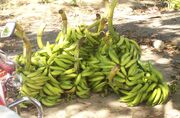
Farmers in Jean-Rabel

Haitian Entrepreneur in Jean-Rabel Market
The economy of Jean-Rabel commune is based on agriculture and its extra activities farming, commerce, entrepreneurship, handicrafts and the exploitation of mines and careers. The context of Jean-Rabel is not different from other municipalities in the lower northwest region. Most people earn their income from the trade of imported products, and in agriculture, especially livestock and fisheries. But it must be pointed out that the activity of producing charcoal has intensified over the last three years, where the number of operators has doubled and the quantity of trucks frequenting the town in search of coal is in net increase. The development of agricultural processing workshops is growing. For the moment the commune of Jean-Rabel owns the workshops of following transformations:
-5 bakeries: 1st section: 1 / 3rd section: 4.
-1 workshop for the processing of whitewood agricultural products (2nd section).
-4 cassaveries: 1st section: 2 / 5th section: 2.
-8 grain mills: 1st section: 2 / 2nd section: 2 / 3rd section: 3 / 4th section: 1 / 6th
section: 1 / 7th section: 1.
-1 micro-processing company of agricultural products in Sauval (2nd section)
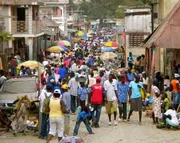
Jean-Rabel Market
The locals eke out their subsistence by farming, a task that is sometimes more challenging because of the lack of machinery and irrigation. Though Jean-Rabel boasts a river, a drought threatens their ability to farm, and they depend on rainwater to harvest their olives, plantains, manyok (yucca), mangos, yam, beans, corn and sweet potato crops. The commune also produces, coffee, campeche, cotton, beautiful timber and cabinetry, salt, wax, scales, honey, pistachios, hides and skins, delicious oranges, and cattle. In the past, the municipality produced an indigo of superior quality. The natural salt marshes of the Grand and Petit Port have water producing very white salt in the spring and a regular crystallization. Exports are facilitated through Port-de-Paix and Gonaïves. The ships sometimes anhcor themselves on the coast of Jean-Rabel, whose port is not open to foreign trade.
Also discovered within the commune are rock crystal, copper, magnet mines, antimony, gemstone, ashlar, sponges, cactus, opuntia, ebony, gaiac, and bees.
Sources of ferruginous and salty mineral waters, whose bitterness announces the presence of rock salt, were discovered at the River Colas on the Sel habitation.
On the economic and financial level, the town of Jean-Rabel has a private morgue, a pharmacy, a hairdressing salon and two photo studios. The lack of many services should be noted, such as petrol station, photocopy service, dry cleaning, port, airport and bank.
Employment
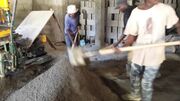
Concrete production in Jean-Rabel
The situation of formal employment in the municipality generally evolves in the same way as the level of the whole country. However, we can note a considerable rise in the amount that has been recorded, especially in the educational sector where 198 professors were appointed to fill some gaps that existed in the system. These nominations were made at all levels. Other jobs more or less have been created in institutions (ADEMA, FAES, AAA, PRODEP, AYITI GOUVENANS, IFOS, CRS). Finally, note that several hundred short-term duration jobs were created by the mayor through the realization of large project spans such as the drainage of the city center and the construction of Vincent village.
Infrastructure
Transportation

They actually call this long strip of mud a "road". Jean-Rabel, NO, Haiti
Jean-Rabel is located on Departmental Route 52.
The city of Jean-Rabel is not fully paved. The streets are the ground and in bare condition. The state of the roads in the rural sections of Jean-Rabel is identical to that of the urban area of this commune.

Route Departmentale 52 (Road from Port-de-Paix to Jean-Rabel)
Education

école Panou de Jean-Rabel
In the field of education, the Ministry of National Education of Youth and Sports is represented in the municipality of Jean-Rabel by the Departmental Direction of the Far-West. There are is a kindergarten, numerous primary schools, 10 secondary schools, a technical and vocational school, 13 literacy centers and a college. There is no university.
The education sector has made significant progress during the period of realization of the 1st PCD:
- school infrastructures have progressed on all the communal sections and the town center, - the number of schools with school canteens has increased, - the number of teachers has increased.

Professional schools of Jean-Rabel
| Name | Habitation | Location | Specialization | Students | Professors |
|---|---|---|---|---|---|
| Professional Center of Dubois | Dubois | Dubois | Sewing, pastry, cooking, floral art | 25 | 1 |
| St-Martin de Porest | Town center | Bois-d'or | Sewing, kitchen | 16 | 7 |
| Bethel | Town center | Rue Jerome | Welding, cabinet-making, masonry, sewing, kitchen, plumbing | 50 | 7 |
| Informatic school of Lacoma | Lacoma | Lacoma | Computer Science | 15 | 2 |
| Craft Center of La Montagne | Nan Jules | Nan Jules | Crafts (Bamboo) | 90 | 3 |
Health
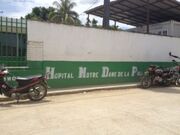
Notre-Dame Hospital
The Ministry of Public Health and Population is represented in the commune of Jean-Rabel by a Health Department. There is a hospital and 11 public clinics. The medical staff consists of: a doctor, 2 dentists, 2 nurses, some laboratory technicians, some radiologists, numerous auxiliaries, plenty of certified matrons.
The health sector remains one of the sectors where the most difficulties are recorded. This is the consequence of the dysfunction of the Communal Health Unit (UCS), whose director was not actually available in the area for the duration of the PCD. This structure is supposed to regulate the functioning of the health system in the commune of Jean-Rabel and has failed in its mission. This situation has also caused difficulties in the health information survey; all the data that we have been able to collect are from the workshops are participatory.
Hôpital Notre-Dame du Bourg is the only reference structure for health care in the municipality. Yet this hospital is not able to provide all services requested by patients due to material constraints, financial and technical (lack of specialists in certain branches of medicine). The few services that are guaranteed are barely functional, the patients and health staff complain. With the support of partners, a drug bank (BMF: Banque de Medicaments du Farwest; Farwest Drug Bank) had been put in place and allows a supply of medicines to the different health structures. A microscope has also come to increase the list of materials available in the area.
However, it should be noted that efforts have been made to increase the staff in some dispensaries set up at the level of several communal sections (1st and 3rd for example). Meanwhile, other sections are still waiting to be able to benefit from the services of a dispensary. This is the case of the 6th section Grande-Source, where the inhabitants denounce the installation of a so-called private sector dispensary, which they also call "Dispansè biznis". Because of this, patients must head towards either Mare-Rouge (communal section of the municipality of Môle Saint-Nicolas) or to the town center of Jean-Rabel. So, it is clear that the victims of cholera had difficulties to seek treatment, given the problems of displacement on the area.
With regard to traditional medicine, this practice is clearly in vogue throughout the municipality. The population resorts to it for all cases of disease with few complications or symptoms to which residents are not customary. Houngans and other practitioners of traditional medicine (matrons, health worker, etc.) are proving to be of considerable support to the local population.
Improving transport conditions will allow better access to health care; some homes can not even accommodate the presence of doctors and nurses in mobile clinics.
Utilities
The sources of energy used and potentialities
The population of the commune of Jean-Rabel has for a long time lived in the dark (blackout). It was not until the first PCD was implemented that progress was made in the field of energy. At present, two main energy supply sources serve the local population: a thermal network covering part of the downtown, and solar street lights located in various places in the communal territory. However, despite these advances, mobilization must be made to correct the weaknesses identified in the management and operation of the thermal plant, weaknesses related to lack of funds (the few subscribers do not pay ...) for supplying the network with fuel.
Access to drinking water
Although there is no comprehensive data on water management in Jean-Rabel, we can say that the town is home to a large number of sources. The most are located in the southern part of the commune where the vegetation cover is relatively dense. Captured sources are encrypted to several tens while there would have more than fifty others who would not be captured. The catchments allow the supply of several fountains located in the northern part as in Sauval (2nd section), Gros-sable (7th section). The Catron spring feeds a 50,000-gallon tank that serves the Downtown core, Vincent Village and Bord-de-Mer (Seaside) area with drinking water. Several catchments and cisterns were either constructed or repaired, however, the following areas still face enormous difficulties in getting supplies: the Pechaud and Boucan-Patriot habitations in the 2nd section, Raymond (1st section), La Montagne (4th section) and Cadette River (6th section).
Administration
The Court of Peace falls under the jurisdiction of the Civil Court of Port-de-Paix.
The garrison of the commune consists of a gendarmerie company, an administrative police, a Môle Saint-Nicolas artillery, the National Guard on foot and horseback.
Culture
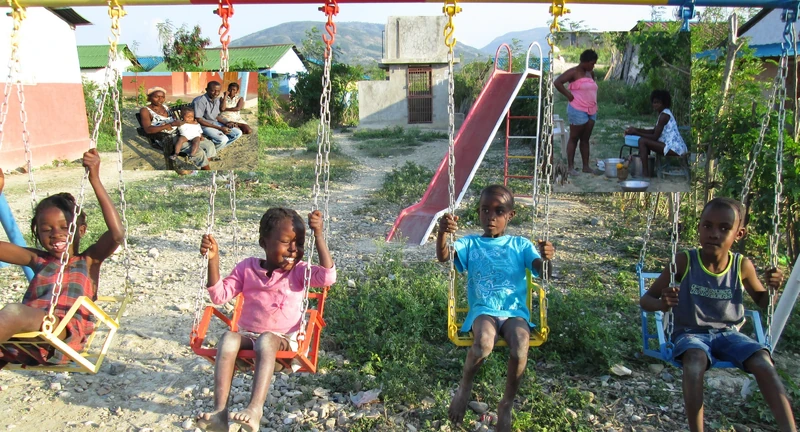
Everyday life in Nan Village Vincent, Jean Rabel, Haiti
Religion
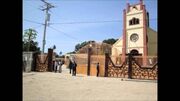
Church
Twenty-six temples, all beliefs combined (except vodun) are counted in the commune of Jean-Rabel. The Baptist temples are predominant and represent 46% of the total. Next are the Catholic and Adventist temples, which represent 31% and 23% of the total, respectively.
The patronal Feast of Saint John is celebrated June 24th.
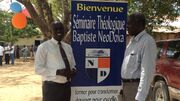
Seminaire Theologique
Organization
The representation of five political parties is noted at the commune of Jean-Rabel. There are also three grassroots organizations, two peasant groups, a women's group, three non-commercial co-operatives, one NGO and four international organizations.
Communication
The telephone service of the town of Jean-Rabel has been in the project phase because the lines were not yet connected. This commune has a radio station. The written and televised press is nonexistent.
Radio is commonly used by a good fringe of the population of Jean-Rabel. The internet is just beginning to be within the reach of people with the Natcom mobile system and Digicel. The number of radio stations has evolved during the last five years where four new stations have been created in the downtown alone. They broadcast programs of an educational, cultural and evangelical nature for the benefit of the people. Some of them retransmit the news editions of Vision 2000 a station of the capital thus allowing the Jeanrabelois to have access to national and international information. A few efforts have been made by the association ADEMA to equip these radios with more efficient equipment to reach remote areas of sections and increase the hours of listening. In addition, several training sessions were held at the intention of the animators.
Access to mobile networks has increased since 2006 with the arrival of Digicel, then Natcom in 2011. We can estimate that more than 50% of the local population have access to a mobile phone; a clear improvement at this level. However, it is important to see whether tariffs can really be considered competitive in the market, especially considering the recent Digicel-Voilà merger.
The post arrives from Limbé to Jean-Rabel on Monday and leaves the same day.
Leisure
In terms of culture and leisure, the town of Jean-Rabel is provided with three libraries, a theater, two cinemas, three nightclubs and six gagueres. Football (soccer) is the only sport practiced. This town is devoid of museums, public places, and monuments.

Celebrity Reflection Caribbean Cruise
| Sectors | Specialties and practices of Jean-Rabel |
|---|---|
| Music | Rara, troubadour, lòkès |
| Sport | Football, Basketball |
| Theater | Role Theater, Satyric Theater |
| Literature | Poetry, Oral Literature (tire kont) |
| Gastronomy | cassave, fish, alette, sweet bread, doucounou, chaka, boy manioc / peas congo, pen joumou, doub motè (pwason bouyi nan ji kokoye), guyguy, pimentade, fricasseé. |
| Architecture | Kay pay |
| Dance | Dance competitions |
| Natural Heritage | Trou Pispis (4tryèm seksyon) |
| Historic heritage | Nan miray cane mill |
| Social relations | Solidarity, hospitality |
| Crafts | Rolled basketry (baskets, trivets, etc.) and traditional (djakout, makout, halfort, layer, chapo), writing on stone |
| Other important distractions | Dezafi, Football (soccer) |
Cultural practices in Jean-Rabel
Sport
Sport, especially football (soccer), is making a name for itself in the lives of Jeanrabélois. So to speak, football (soccer)-related activities (local or regional tournaments, broadcast of international matches ...) always cause great crowd gatherings. However, the related infrastructure still leaves room for desire. Apart from football (soccer), almost no other sport arouses so much interest and passion among the inhabitants of this commune of more than 140,000 people. Only basketball reserves a small place seasonally on the billboards at the level of the communal section.
From an organizational point of view, Jean-Rabel owns a football league founded since then over the years and which has about a dozen affiliated clubs. This league regularly organizes seasonal championships and seasonal tournaments for the young. In addition, the municipality has a sports monitor, which with the help of local volunteers, organize the annual inter-school football (soccer) championship.
It should also be noted the involvement of other personalities in the organization of leisure and recreation activities (festival, recreational day, activities Konbit Vakans Summer 2012 ...) for the youth.
On the other hand, it is visible that the sports facilities (football {soccer} fields) are not sufficiently well-designed to encourage the practice of sport. Most of the land is not fenced nor suitable (no leveling ...); in In some cases, these are rented spaces that are only available during the dry periods when appropriate (case of Lalande 5th, for example).
Recreation
| Types of recreational areas | Quantity | Location |
|---|---|---|
| Football (soccer) Fields | 35 | Citywide |
| Cybernetic Center | 1 | Guinaudée (2nd) |
| Gaguères | 52 | Citywide |
| Cultural Centers | 2 | Town center |
| Guest-Houses | 2 | Town Center / Cabaret (1st) |
| Hotels | 4 | Town Center |
| Movie theaters | 12 | Citywide |
| Restaurants | 9 | Citywide |
| Nightclubs | 3 | Town Center / Guinaudée (2nd) |
| Multi-purpose House (intermittent operation) | 1 | Town Center |
Distribution of leisure areas in the commune of Jean-Rabel
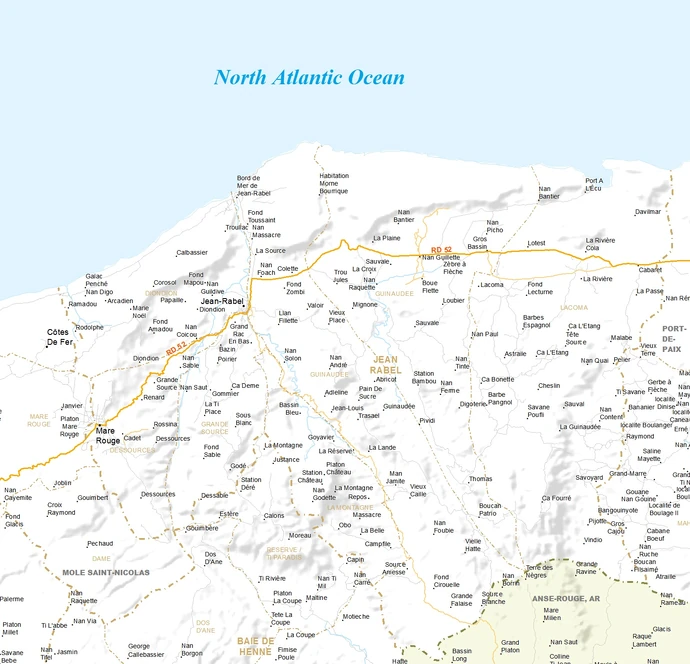
Neighborhoods
| JNR | Jean-Rabel | 148,416 | ||||
|---|---|---|---|---|---|---|
| VJB | Ville de Jean-Rabel | Urban | 11,298 | |||
| QBD | Quartier de Bord de Mer | Urban | 1,966 | |||
| LMA | 1ère Section Lacoma | Rural | 25,265 | Astraile, Barbe-Pangnol (Barbes Espagnol), Boucan-Filsaimé, Cabaret, Ca Bonette, Ca Fourré, Ca l'Etang, Cheslin, Davilmar, Fond-Lecturne, Lacoma, La Guinaudée, La Passe, La Rivière, La Rivière Cola, Lotest, Malabe, Nan Content, Nan Quai, Pelier, Pijotte, Port-à-l'Ecu, Sauval, Savane-Poufli, Savoyard, Tête-Source, Ti Savane, Vindio | ||
| GUI | 2ème Section Guinaudée | Rural | 23,423 | Boucan-Patrio, Boue-Flette, Digoterie, Gros Bassin, La Croix, La Plaine, Loubier, Mignone, Nan Bantier, Nan Ferme, Nan Guillette, Nan Paul, Nan Picho, Nan Raquette, Nan Tinte, Pividi, Pointe-Jean-Rabel, Sauvale, Station-Bambou, Thomas, Trou Jules, Zèbre-à-Flèche | ||
| VIH | 3ème Section Vielle Hatte | Rural section | 23,701 | Abricot, Bord-de-Mer-de-Jean-Rabel, Colette, Fond Cirouelle, Fond Toussaint, Fond Zombi, Grande-Falaise, Guinaudée, Habitation Morne Bourrique, Jean-Louis, La Lande, La Reserve, Nan André, Nan Fillette, Nan Foach, Nan Foubie, Nan Massacre, Nan Solon, Pointe-Saline, Source-Aniesse, Source-Blanche, Trasaël, Valoir, Vielle Hatte, Vieux Caille, Vieux-Place | ||
| LMT | 4ème Section La Montagne | Rural | 12,240 | Bassin-Bleu, Campfile, Goyavier, La Montagne, Massacre, Nan Godette, Platon-Chateau, Repos | ||
| DSC | 5ème Section Desources | Rural section | 13,272 | Cadet, Dessources, Grande-Source, Menard, Nan Sable, Rossina | ||
| GSO | 6ème Section Grand Source | Rural | 24,628 | Bazin, Ca Deme, En Bas, Fond Sable, Godé, Gommier, Grand Rac, La Ti Place, Nan Saut, Poirier, Sous Blanc | ||
| DDI | 7ème Section Diondion | Rural | 12,983 | Arcadien, Calbassier, Corossol, Diondion, Fond-Amadou, Fond-Mapou, Gaïac-Penché, Marie-Noël, Nan Coicou, Nan Digo, Nan Guildive, Papaille, Rodolphe, Troullac |
References
Transforming Agricultural Lands in the Far West [1]
Jean-Rabel development plan [2]
Michael Vedrine
